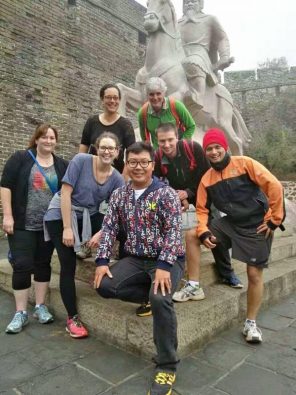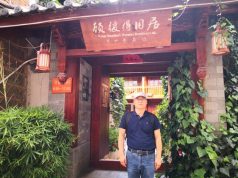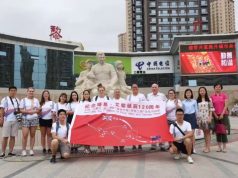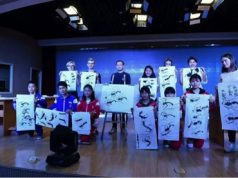
This the second part of a daily record of the visit to China of a group of 6 people, including some NZCFS members, to a number of interesting environment-oriented institutions as well as sites of ecological and environmental significance throughout China. Kirk McDowall has written a full and fascinating account of the efforts of the Chinese people to address many of these problems and, in many cases, implementing their solutions. Kirk gives details of each day’s visits and discussions. See Part 1.
“A man who has never been to the Great Wall shall not be considered as a hero”, Chairman Mao Zedong.
The next day we visited the Jinshanling section of the Great Wall of China, a less touristic and rugged section of the Wall. Here we became ‘heroes’ taking a number of selfies with the school groups also visiting. That evening, we also visited Tiananmen Square and the Forbidden City Palace.
The Beijing Municipal Bureau of Environmental Protection (BMBEP)
On Monday, we visited the Beijing Municipal Bureau of Environmental Protection (BMBEP), which is in charge of the environmental protection work in the city area. From 1998 to 2016, there has been a 75% increase in Beijing’s population, which, according to some estimates, reached 21.7 million at the beginning of 2016. However, there is a large ‘unofficial’ additional population, which includes people without resident cards [Beijing Haikou], and the total population may be 26-30 million across the 16 districts of Beijing (with one new district under construction).
Pollution was a key area of discussion. Beijing is surrounded by mountains on three sides, and a lack of rain and wind means the pollution from factories and industries tends to stay in the region. As a result of growing public and international concerns around pollution in Beijing, the quality of air, water and soil has been the main focus for the BMBEP. Since 2013, there has been an investment of US$11 billion into the improvement of the polluted environment, which has resulted in a 15% decrease of fine particulate matter (PM2.5), which is an air pollutant of concern for people’s health when levels in air are high. In addition, PM10 has decreased by 50% in the last ten years. Furthermore, three out of four of Beijing’s coal-fired power plants have been converted to gas, and the last one will be converted later this year. As a result, the annual consumption of coal has reduced from 22 million to 12 million tonnes in the last three years. Despite this, 60-70% of energy for Beijing comes from other parts of China, generated by coal, hydro and gas.
There has also been a focus on green energy by the Beijing Municipal Local Government. There has been an increase of 35,000 electric vehicles and the removal of old vehicles by means of monetary incentives. Every two months there is also a car lottery – each permanent resident can apply for a ticket and every year there are maximum of 20,000 tickets drawn for a new gasoline car, and 60,000 tickets for an electric car. Residents need a ticket to buy a new car, so this initiative is limiting the number of new cars on Beijing’s roads at the same time favouring electric cars.
The National Government has been implementing emission standards across the country, and the strictest are in Beijing, which means a number of industries are being shut down or relocated. The BMBEP works closely with industry to assist in retrofitting options from coal to gas, or to reduce emission levels, and can provide financial assistance. However, some industries have preferred to relocated to provinces with less strict standards, which means there needs to be a total Government approach for air pollution. As a result, there are regional co-operation initiatives, such as Beijing-Tianjin-Hebei Provinces, working together to improve air quality across the region and to set emission standards, thus aiming to prevent the relocation of polluting industries around China.
Following our discussions with the BMBEP, we met the Secretary of the Chinese Renewable Energy Industries Association. The Association was set up in 2000 with over 200 members, consisting of companies and industries in geothermal, solar heating and biomass energy, and the Association works with the National Energy Administration of the National Government. The main objectives are to organise conferences for interested universities and companies, assist with research, and facilitate discussions on relevant topics between industry and government.
In 2015, non-fossil fuel accounted for 11.6% of total (National) energy consumption, and the Government’s target for 2020 is to increase this to 15%. However, despite the relatively small percentage of renewable energy compared with fossil fuel when compared to New Zealand (80%), the amount of energy produced is significantly different. By 2020, China aims to produce 250Gw of wind power (with 2000Gw of total energy produced), compared with New Zealand’s 10Gw of total energy produced, highlighting the difference in scale between the two countries. There has also been a push to encourage more renewables in China, including larger subsidies for the use of renewables thus curtailing the use of fossil fuels. However, fossil fuels must continue to underpin the production of renewable energy, especially as the demand for energy across China increases. As a result, in the long term, there is likely to be greater use of natural gas as it is cleaner than coal, but still high in carbon dioxide. We also spoke about the potential for the increased use of nuclear, but many people in China believe it is unsafe and are against it.
In relation to manufacturing of ‘renewable’ technologies, China is the largest manufacturer of wind turbines and solar panels. The majority of solar panels are exported overseas to the United States, Germany and Japan, while the majority of home-built wind turbines are used within China due to international competition. China also has the largest number of wind turbines and solar panels in the world. In relation to other renewables such as hydroelectric and marine [tidal and wave], geothermal and carbon sequestration/storing are largely in the initial research and development stages and have not yet been commercialised.
The Chinese Renewable Energy Industries Association
We also spoke about carbon policy and carbon trading with the Chinese Renewable Energy Industries Association. From 2012, the Chinese Government has been developing a National Carbon Market that will be rolled out next year. Each province will have a carbon limit cap, which will create a cap for each city and industry in the province, and trading can occur across the country. The cap is based on a percentage of the past three years of carbon emissions data. In 2016, ten billion tonnes of carbon dioxide are released each year by China, and the carbon market will cover 60-70% of these emissions (the remaining 40-30% includes carbon dioxide released naturally).
In relation to electric vehicles, there has been recent promotion of these in the cities of Hangzhou, Nanjing, Beijing and Shanghai. However, more development and infrastructure is required for larger uptake of these vehicles. The capacity of the battery (less than 300km) as well as the relatively low number of charging stations in big cities and the time required to charge are deterrents for people to use electric vehicles, especially for those who will be driving to other cities around China.
Finally, we spoke about the public’s increasing awareness of climate change. Since 2008, the public’s perception of climate change has increased due to the more frequent extreme weather events in and around China, including the large snowstorms in Henan and more frequent flooding in Beijing. Also speaking to residents in cities around China, there is strong awareness of the degrading environment and growing pollution in their country.
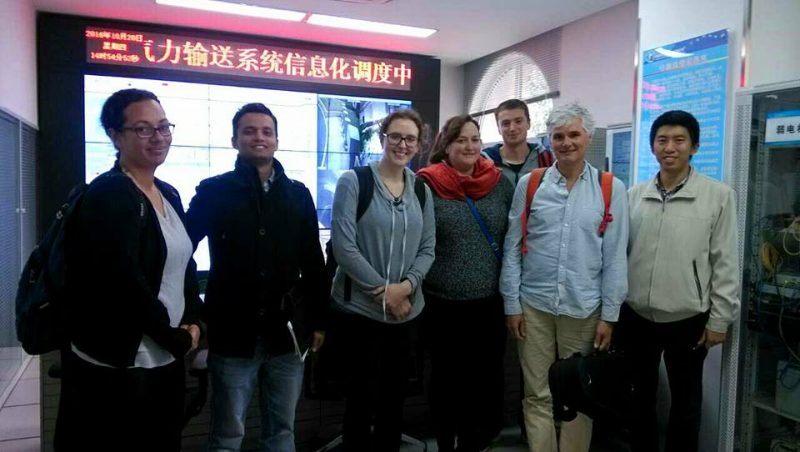
Beijing Goldenway Biology Tech Co Ltd
The next day, we met with staff at Beijing Goldenway Biology Tech Co Ltd, a waste-treatment facility that uses microbial technology for treatment of organic waste resources, has developed environment-friendly bio-fertilisers and actively promotes prosperous developments in ecological agriculture. Approximately 600 tonnes of kitchen waste are collected each day in Beijing, and the site handles 400 tonnes per day. Goldenway Biology Tech is currently building three new sites to handle the additional 200 tonnes of waste produced each day, as well as treat waste from large restaurants and schools. There are also residential-waste pilot projects in some high-rise apartments in the city. Goldenway Biology Tech was set up by the government, but is manned by industrial experts. It has bases in 14 major cities around China. By 2020, the company intends to have facilities in all towns and cities in China with a population of over 500,000 people, which equates to over 200 cities.
Goldenway Biology Tech produces fertiliser from the waste, which is then used in Beijing and other provinces. Soil quality is decreasing around the country. Thus there is increasing demand for this fertilizer product across the country.
The Institute of Environment and Sustainable Development in Agriculture (IEDA)
In the afternoon, we met with staff of the Institute of Environment and Sustainable Development in Agriculture (IEDA), a non-profit organisation affiliated to the Chinese Academy of Agricultural Sciences, and which leads agricultural environment studies in China. IEDA carries out research in responding to emerging challenges such as climate change, more frequent disasters, increasing water scarcity and degraded agro-ecosystems. They generate scientific knowledge and conduct research specifically in relation to the impact of climate change and adaptation to it, greenhouse gas emission mitigation, agricultural disaster prevention and reduction, and agro-environment engineering. The IEDA has a number of projects and collaborates with the Food and Agriculture Organisation and Intergovernmental Panel on Climate Change and with the Governments of the United States, Japan, Australia and New Zealand.
National Agricultural Science and Technology Demonstration Park
We also had the opportunity to visit the National Agricultural Science and Technology Demonstration Park, which incorporates environmental engineering practices for horticultural. The demonstration park has a number of different horticultural practices, including vertical farming, use of LED lighting, and horticultural products that are being used in restaurants and malls around the city.
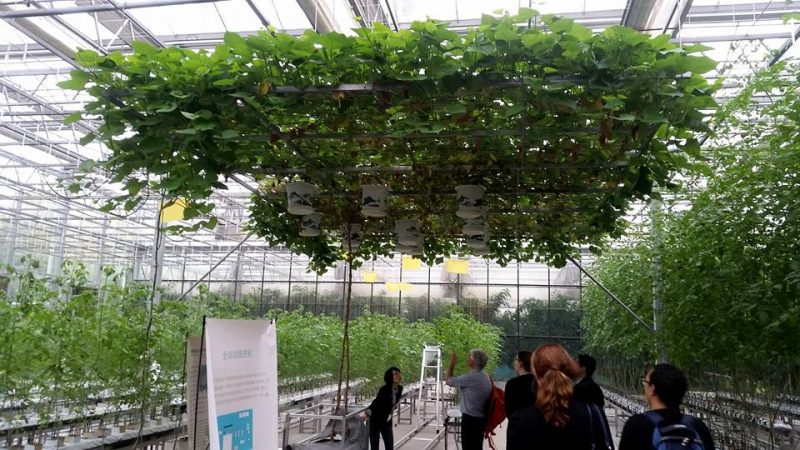
Following our time in Beijing, we spent the next few days travelling to Baoding to meet with the world’s largest manufacturer of solar panels, then on to Yingli, and Tianjin, to visit the Sino-Singapore-Tianjin Eco City.
Baoding and Tianjin – Yingli Solar – Ecocity
After spending a few days in Beijing, we travelled to Baoding, 160km away in the Hebei Province. However, the trip took a large part of the day because the smog was so bad on that day that the highway was closed, so we had to take alternative routes. During our time in China, we had an air quality app, which informed us of the air quality index and the level of particle matter found in the air (PM 2.5), in the cities we visited,. That day, the air quality index was 348, which was considered hazardous and the entire population was likely to be affected, with the PM2.5 was 298.2 µg/m3, which is hazardous to health.
When we arrived in Baoding, we visited the largest solar panel manufacturing plant in the world, Yingli Solar. Yingli Solar has manufacturing facilities in Baoding, Haikou, Tianjin and Hengshui, and a research and development lab in San Francisco. Yingli Solar modules are deployed worldwide and these generate over 15GW. In 2012, Yingli Green Energy reached a production capacity of 2,450MW per year, making it the largest solar-module manufacturer in the world in terms of module production capacity. One GW of photovoltaic module can meet the electrical demand of more than 300,000 households, or over 40 million lamps, and can reduce carbon dioxide emissions by more than 700,000 tonnes per year. This is the equivalent to taking approximately 150,000 cars off the roads.
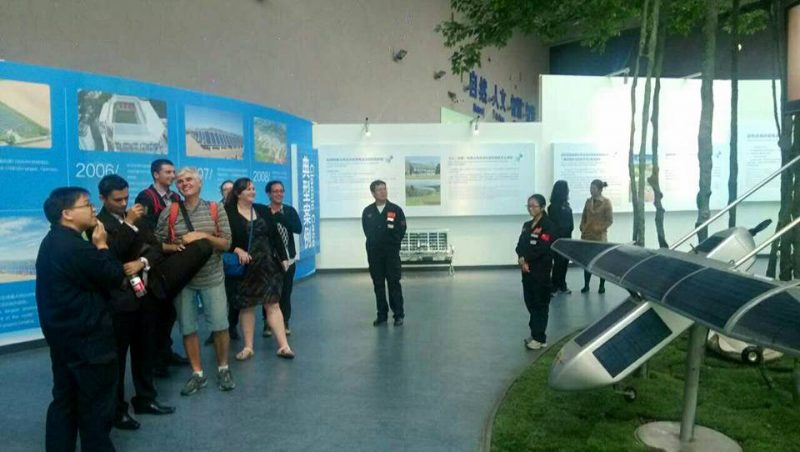
We spent the afternoon talking to staff at Yingli, and also visiting their manufacturing facility, where we walked around the floors and got to see the final stages of the manufacturing process. We went around their facility, where all buildings were covered in solar panels. We also visited the Yingli Low Carbon City Park, a large solar-panelled building that was similar to a forested area with areas for members of the public to relax – a number of open restaurants, fitness and relaxation zones surrounded by hundreds of trees, all within a glass building that was covered by solar panels!
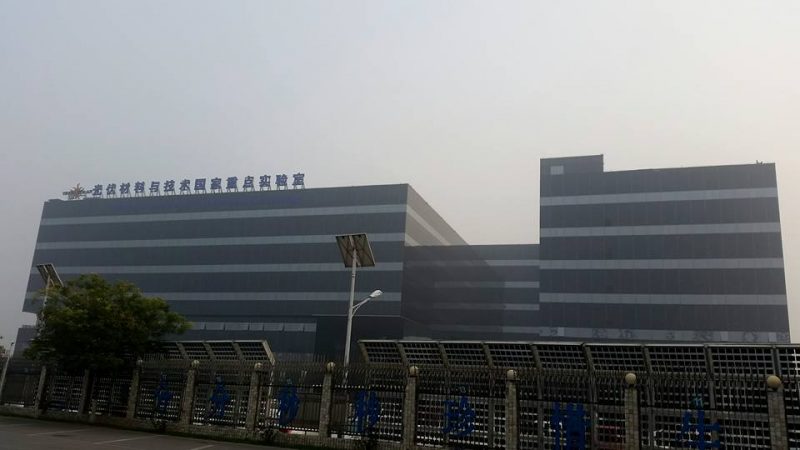
The Sino-Singapore-Tianjin Eco City
The next day we travelled from Baoding to Tianjin, to visit the Sino-Singapore-Tianjin Eco City. The Eco-City is the result of a collaborative agreement between the governments of China and Singapore to jointly develop a socially harmonious, environmentally-friendly and resource-conserving city in China. This is against the backdrop of rapid urbanisation and increasing global attention to the importance of sustainable development. The framework between the two governments was signed in 2007, and a 30km2 area was selected near the Tianjin city centre. Prior to the development of the Eco-city, the site comprised mainly salt pans, barren land and polluted water-bodies, including a 2.6km2 large wastewater pond.
The goal is to develop the Eco-City by 2030, and the start-up area (8 km2) was completed in 2013. There are currently 40,000-50,000 people living in the city, and it has a planned population of 350,000 when the city is completed. Currently all the new houses built in the city are sold, and house prices are generally cheaper than in the Tianjin city centre, while 20% are in the form of subsidised public housing. In addition, the city has a number of Key Performance Indicators for 2020, with all buildings meeting green building standards, at least 90% of trips in the city being green trips (walking, cycling or public transport), and at least 20% of energy utilised in the city to be in the form of renewable energy, with no heavy-polluting industry within the city.
Within the Eco-City, the two governments have piloted several waste-management projects to test their suitability: a series of underground pipes that collect recyclable waste from different parts of the city, sending it to processing centres in the city; local citizens are given incentives, such as discounts, to recycle their waste. During our time there, we visited a processing plant to see the machines in use.
The plan is to use the Singapore-Tianjin Eco City as a model for future Eco-Cities around China and other parts of the world, as well as an opportunity to implement and pilot new green technologies developed by the two governments.
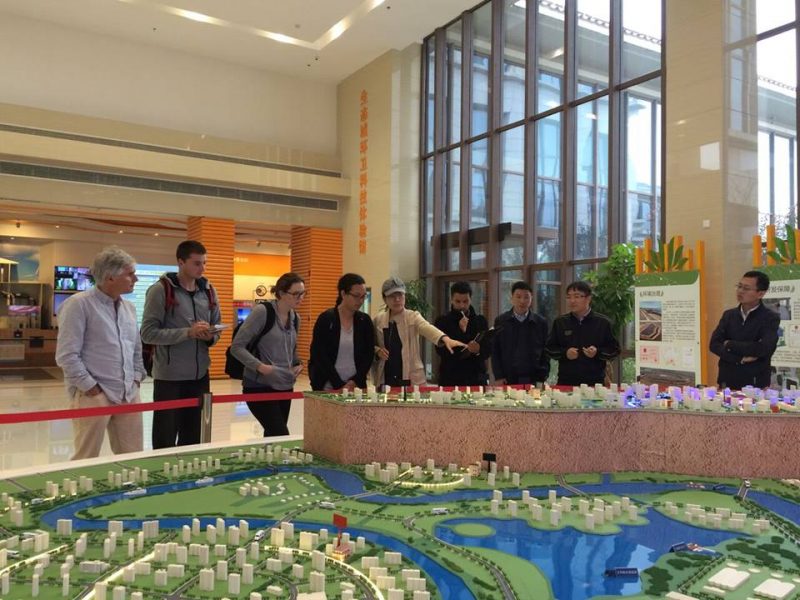
Nanjing Institute of Geography and Limnology and Hohai University
Following our time in Tianjin, we travelled by fast train (going 307 km/hour) down to Nanjing, the capital of the Jiangsu Province, on the Yangtze River (the longest river in Asia and the third-longest in the world), which was the national capital for part of the Ming dynasty. During our time in the city, we visited the Nanjing Institute of Geography and Limnology and also Hohai University, to give presentations on New Zealand’s biodiversity, Maori culture and freshwater lakes in New Zealand. The audience included researchers and professors, as well as undergraduate and postgraduate students.
Dongtan National Nature Reserve on Chongming Island
The final city we travelled to, as part of the Environmental Delegation’s programme, was Shanghai, with an official population of 25 million. We left the city centre and headed to the Dongtan National Nature Reserve on Chongming Island, with Shanghai Youxie. To get to the island, we drove 10km under the Yangtze River, and then over a 6km bridge. Encompassing 750 square miles, Chongming Island is the world’s largest alluvial island, formed from deposits of the Yangtze River. In a given year, one million migratory birds representing 290 species, including waterbirds such as cranes, herons, geese, ducks, gulls and shorebirds, use Chongming as a destination for resting and wintering, when travelling along Asia’s north-south migratory route from as far away as Alaska, Russia, Australia and New Zealand (a 22-30,000km round trip).
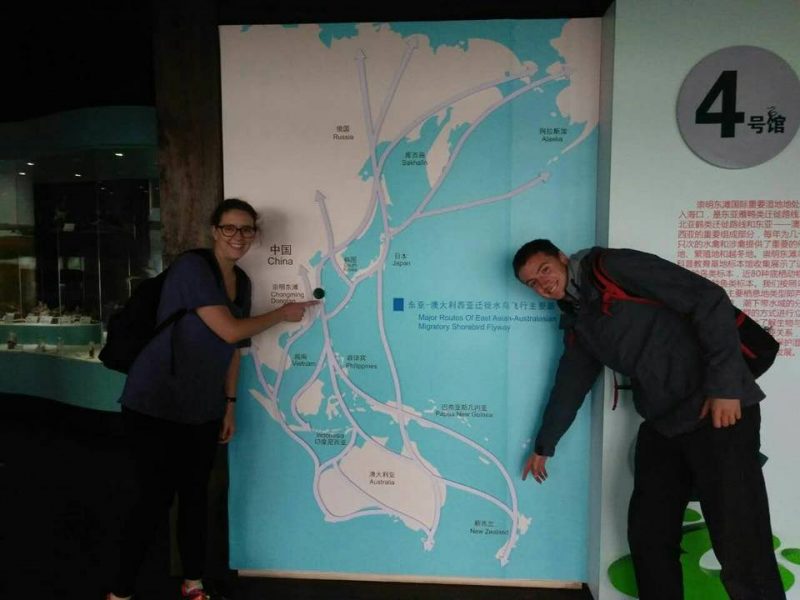
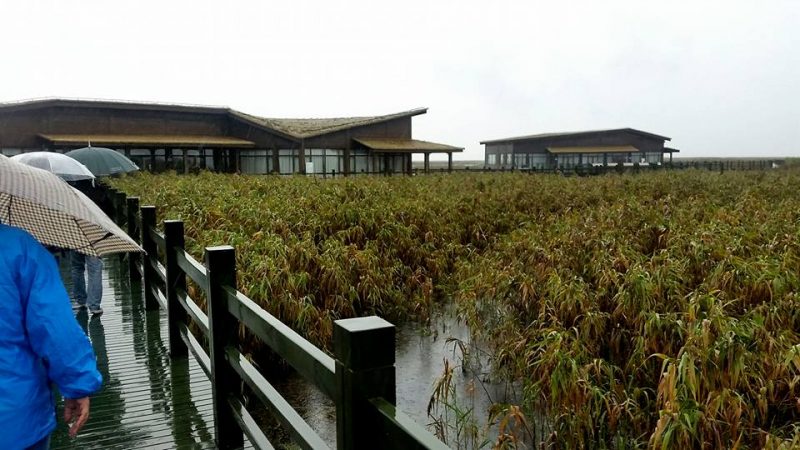
In 2006, the Chongming Dongtan National Nature Reserve was established, a 24,000 hectare wetland reserve. This helps to ensure the area will be protected from development, and there are co-operation projects with New Zealand, Australia, Canada and the United States. During our time at the nature reserve, we walked around the wetlands, visited the Dongtan Bird House and information centre about the island. Upon returning to Shanghai city, some of us explored the city, visiting parts of the Bund, People’s Square, and the two Nanjing Roads.
The ‘Environmental Delegation to China 2016’ was an amazing experience, giving us unique insights into the environmental status and current and future challenges for China. We are very thankful for the number of organisations that supported and assisted the delegation. We aim to continue to build and strengthen the relationships we made around China, and hope to contribute to organising more environmental delegations to China in the future.
I acknowledge the help of the other delegates in producing this diary:
- Deborah Robertson, Master of Marine Conservation (MMC), Master of Environmental Planning (MEP). Natural Resources Specialist.
- Emma Hill, MMC. Climate Change Analyst.
- Marc Schallenberg, PHD in limnology (freshwater science). Research Fellow, University of Otago.
- Leana Barriball, MMC. Manager, Resource Management & Communications Te Runanga o Toa Rangatira.
- Shreejan Pandey, Master Electrical Engineering. Manager of Electric Power Engineering Centre, University of Canterbury.
Thanks go to the sponsors of the delegation:
- NZCFS Simon Deng Li Fund
- Beijing People’s Association for Friendship with Foreign Countries (BPAFFC) [Youxie]
- New Zealand China Council
– Kirk McDowall, NZCFS Wellington Branch Member,
Master of Developmental Studies. Strategy and Risk Adviser.
Click here for Deborah Robertson’s official report as Delegation Leader (which includes more illustrations of the Delegation’s work). Click here for Part 1 of Kirk McDowall’s Diary.


